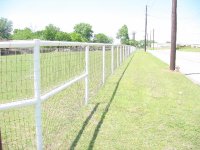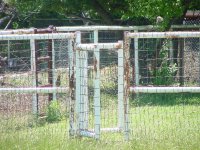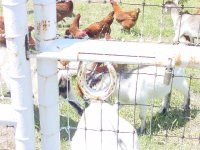Morning Ron,
The only time I've seen real problems with well installed fabric fencing bowing out from animals riding it has been with small pens and too many animals, feedlots, dairies, rodeo grounds etc.
If you think it's gonna be a problem then seriously consider V Mesh. It's twice the price of two by four but in my opinion it's three times the fence. And that is what I've always heard referred to as H-3, the normal V Mesh.
I've done one job with J-2 which is a heavier gauge V Mesh. It was back in the old days when I was a charger and had a real company with employees and secretary etc. The fence was for a super high dollar throrobred stud. I remember when we had it all finished walking around the inside of the fence with the owner and going over every square inch of fabric to make sure there was nothing that was sticking out to hurt the horse.
Of course his stall barn was cinderblock with a two inch layer of soft stucco on the inside walls and he had a special rubber padded floor that was almost Olympic wrestler quality.
What I've learned about horses over the many years of dealing with their owners is that horses are the blonds of the animal kingdom. They're gorgeous but gawdawful dumb at times.
I've got a saddle maker here in Wylie that makes me my rod pouches. He has to do one about every eight years or so. And that's with him usually doing two or three patches on the current one. He uses blacksmith apron leather. It's to my design but he's the one that makes it so great.
The reason I mention this is a long time ago I learned that the worst thing you can do when welding up a fence where livestock is gonna be is to drop your used rod ends. Mine all go right back into the pouch. That's why he has to occasionally patch it. He rivets a double layer at the very bottom because of this but still in three years the thread will burn out and a rivet or two will loosen up.
A piece of steel rod about two inches long and an eighth in diameter will wreck havoc on the digestive track of a horse or cow. Even and especially if they are extremely valuable emotionally and or financially. I've never had a problem. But I was most fortunate that one of my early customers had heard about such a problem and was on me like a bad coat of paint about the potential. I never forgot it.
The same rule applies for when you do your ends of the fabric and splices. All those little pieces go into the welding rod pouch. I have a pouch on my pouch for pliars. Normal everyday use I carry a pair of slip joints. When I'm doing wire fencing of any kind I carry a pair of fence pliars instead.
Another thing is on the stretching. Stretching V Mesh is a bugger bear. It's just plain hard work. Sorta like digging the post holes. You just bear down and do it right and years later you can drive by and a grin will start deep inside and work it's way out.
The good thing is it comes in hundred and sixty five foot rolls so you don't have to splice as often as with two by four which comes in hundred foot rolls.
What I do is do one end. I then roll out the wire. If it's more than one roll long I'll do a temporary stretch. I make a stretching board if I don't have one. (they develop legs almost as bad as post drivers, friends.......) the way I make my stretching board is I take good two by fours. I like to use the oak you get in pallets if you can. I like them at least two inches longer than the height of the wire, preferably four inches. That is so the top and bottom horizontal strands are firmly gripped also. On two by four these are the bigger gauge strands.
I take two pieces of quarter by one and a half flat bar the same length as my boards. I drill three eighths holes in them together so they exactly match up. I then cut two pieces of three eighths round stock just a tad longer than the straps-boards. These round pieces I bend together at a sharp angle. I want them to be exactly alike. I want the ends of the round bar to meet the flat straps about a foot from the bottom and the top of the straps. I weld them to the straps. I usually weld a stabilizer across the round stock about half way between the angle and the board. I drill through my holes in the flat bar through the boards.
Then I tack, not weld solid three eighths bolts to one of the bars. This is when quality bolts are a necessity. If you grab them out of your bargain bin at the box home improvement store they're only going to be good for a couple of uses. So you use quality bolts and you tack them because you will wear them out and they will have to be replaced. If you weld them up solid then that chore is twelve times as hard.
I use wing nuts instead of conventional nuts. The reason I do this is then I only need the pliars I have in my pouch to secure it and with wingnuts I can snug it up by hand before I hit if for the final touch with the pliars.
So I've rolled out a hundred and sixty five feet. I put on my stretching board about five feet from the end of the roll. If the framework is welded (some folks do all of this with galvanized framework like they use in industrial chainlink applications which is good too). If the framework is welded I'll grab a post about ten feet past the end of the wire and with a Massdom Power Pull or something comparable I'll snug it up until the wire is tight. Then I'll go back and tie for about the first hundred and thirty feet or so.
I like to use a cable jack, Power Pull, to pull it tight over doing it with a tractor or truck. Mostly cause I work by myself but also there's no slipping back if someone doesn't lock down the vehicle at just the right moment. Also it gives me more of a sense of the amount of force I'm using.
The way I usually gauge tight is I pull until my teeth hurt. What I mean by that is I pull until I get real nervous about the fact that I might have it too tight. Then I very carefully pull it a couple of more licks just in case.
If this pull is in a long section make sure your cable jack cable is on the frame side of the wire. This allows you to do splice in the next roll comfortably. It's hard to do to begin with and every bit of comfort you can engineer in is well worth the effort.
If the pull is less than the length than the length of the roll of fabric then I will set my truck sideways beyond the last post. A tractor will do but I use my truck. It's got tools and weighs twelve thousand pounds plus before two hundred pounds of orneriness climbs in behind the wheel.
This makes making up at the last post much easier. You don't have the complications of working around your cable jack or trying to pull tight that little bit of wire between the boards and your end post.
What I do is I guesstimate, approximately three and a quarter times the diameter of the post twice, etc. I guess just a tad longer than what I think it will take to wrap the post with a horizontal wire and cut it.
I do the middlest horizontal wire first. With V Mesh it's a pair of wires, I told you it was harder to work with. I next skip up one. Then I skip from the middlest one down one, back and forth until I I have every other one done and tight. I then do all those I missed. It's done and tighter than anything you could ever truly love as much.
I don't wear gloves when doing this. I pay the price. But after about two horizontals you should have an idea exactly where to cut so that you have the amount where you can use just your fingers to wrap your joint. What I usually do is do two wraps. Then after I've got the wire cut when everything is done I'll come back with the fence pliars and tighten it all up. Try to keep your ends in as tight to the fabric as possible.
Horses can't see squat up close. That's why when you move your hand towards them they jump back. You've startled them. So if you have an end sticking out two or three inches they won't see it if they're investigating something by that piece of wire until it's in the eye.
One of the reasons I don't have employees per se is because I'm hell on wheels about the little things like that, wire ends, rod ends, clean holes, etc. It's just hard to get folks to understand there are rules to be broken and there are rules never to be broken. Much less teaching them which is which.


